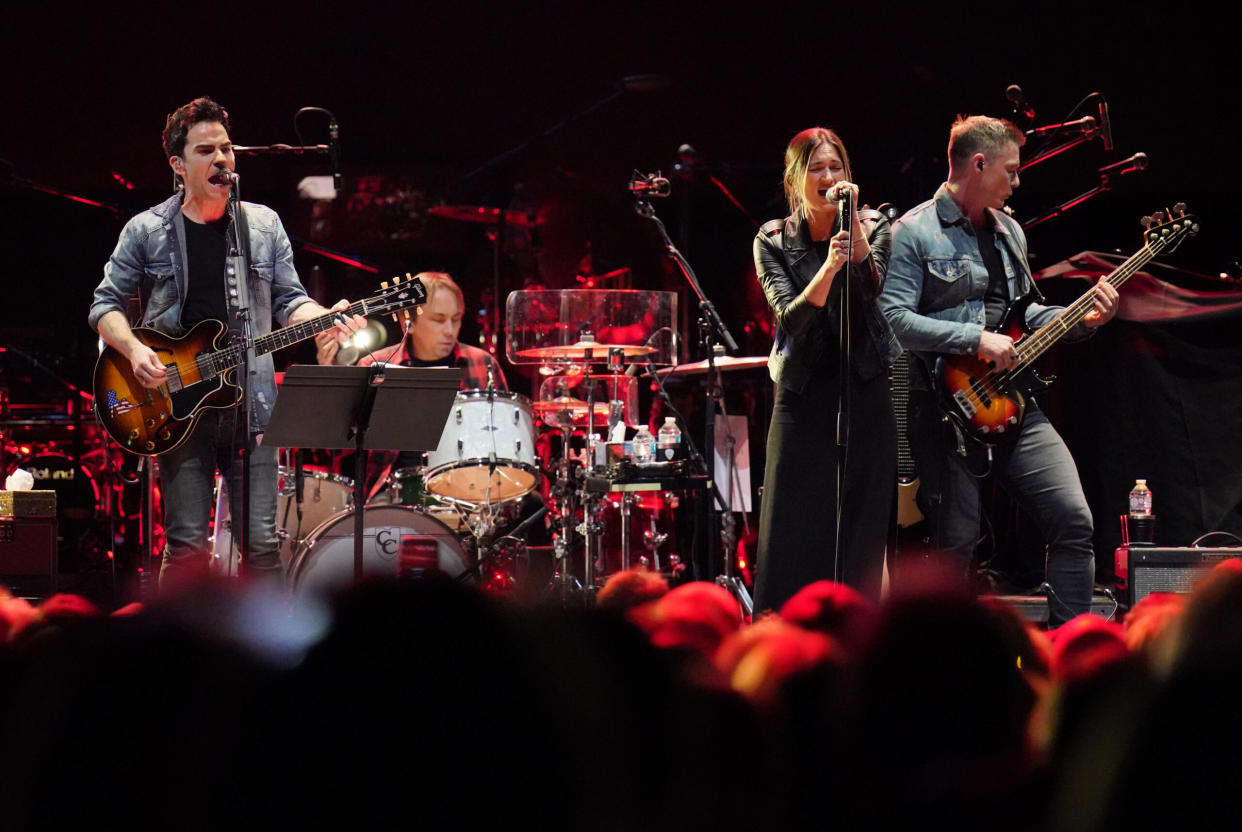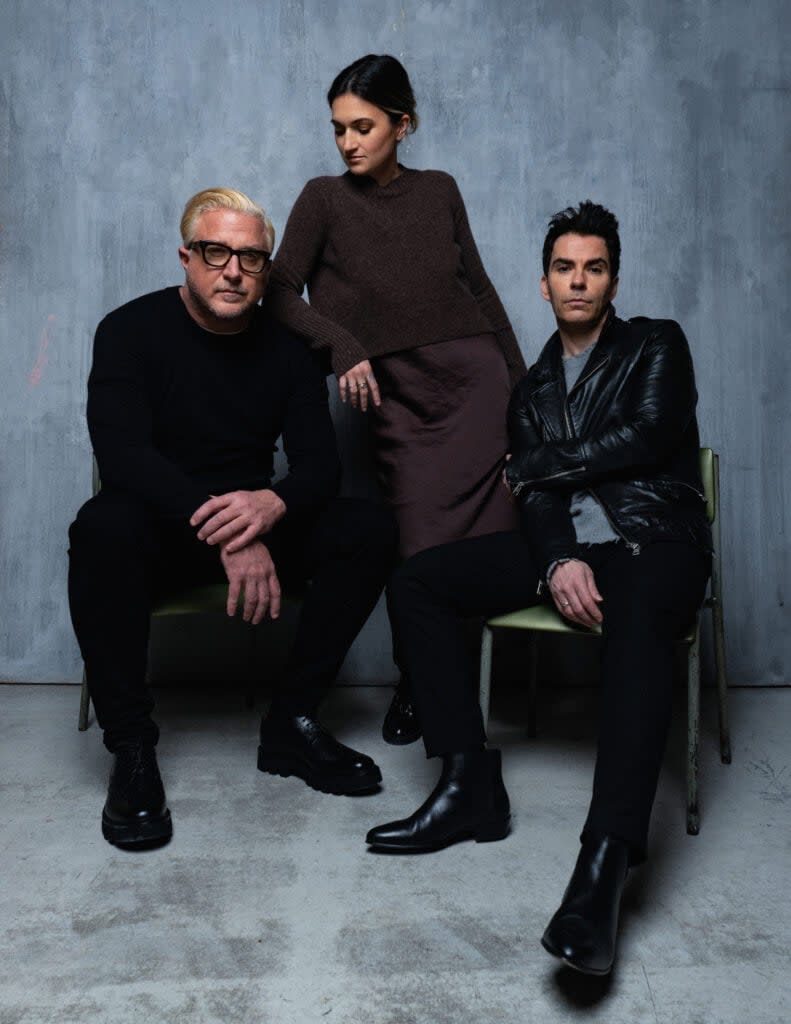Kelly Jones: ‘I’ve Always Had A Very Country Slant To My Songwriting’

- Oops!Something went wrong.Please try again later.
Far From Saints is an unlikely marriage between Welshman Kelly Jones—who, with his stadium-filling rock group Stereophonics, has had eight No. 1 albums in the U.K.—and Patty Lynn and Dwight Baker of the Austin-based Americana group the Wind and the Wave. The Wind and the Wave supported Stereophonics 10 years ago on their North American tour—which they were brought onto within hours of the first gig. Prior to that tour, Jones knew nothing of the duo, and while Baker had heard a few favorite Stereophonics songs, Lynn was quite unaware of them.
They began writing together in 2019, when the Wind and the Wave supported Jones on his U.K. solo tour, and recorded their self-titled debut album in nine days—then had to shelve it for four years over the pandemic. When they came back to the album this year, the commitment to their creative decisions on Far From Saints remained steadfast. One of their first shows as Far From Saints was at the Royal Albert Hall for the U.K.’s high-profile Teenage Cancer Trust charity concert—for which Jones has been an ambassador for 24 years. They’ve also supported Kings of Leon and Paul Weller.
More from Spin:
5 Albums I Can’t Live Without: Kelly Jones of Stereophonics/Far From Saints
Watch Mammoth WVH and Stereophonics Cover Foo Fighters in Honor of Taylor Hawkins
This summer, Far From Saints embark on their own tour, which includes small festivals. “I really enjoy that because it means you go on in the middle of the day,” says Jones. “You’re trying to win over somebody else’s audience again. It’s a nice challenge to share with different people, traveling in a little van and doing these opening slots.”
With Jones based in London and Lynn and Baker across the ocean in Austin, just getting everyone from Far From Saints in the same room is a challenge. But they miraculously converged to chat with us about their new album as an Americana/folk/rock-country trio.

You started writing this album backstage while you were on tour together, right?
Patty Lynn: Yes. We can remember exactly where we were. It was Kelly’s birthday, there was a cake, we were walking off the stage, and he said, “We should write together.” Dwight and I were like, “Yeah, okay, cool, sure.” The rest of the tour, they had a space set up for us to work backstage if we wanted to. We would get together almost every pre-show and tinker around. We didn’t have any idea what it was going to sound like. I don’t think anyone knew it was going to become a project in its own right.
Dwight Baker: A lot of times Kelly would send me a riff from his phone that he’d written or never finished or that might have a little vocal idea. Because I had nothing to do on that tour other than play guitar, I would work on it and turn it into a song with a melody and hand it off to Patty. They would text and email lyrics back and forth to each other at night, and then we cut it.
How did your working process progress once you got into the studio?
Kelly Jones: The tour was split into two legs. After the first leg, we did a couple of days in the studio to see if anything happened. We went to a studio owned by Sam Dyson [son of James Dyson of the household appliance company]. We didn’t have much time, so we recorded just the vocals live first, just to see how they sound together, with myself and Dwight producing with a great engineer, Phil Parsons. I’m on one side of the live room, Patty’s on the other, and Dwight’s in a sound booth. It’s kind of a backwards way of recording. But you start from the exact tone of what the record is going to be, which is the two voices.
Lynn: That was the first time I’d ever recorded my vocals live, together, at the same time. Kelly’s voice is so iconic. I was worried I wouldn’t have an easy time being able to line up and match his phrasing. He was worried about the same thing because I have some really weird rhythmic phrasing sometimes.
Baker: There is something magical about starting a song in its rawest form and getting the vocal and the acoustic to where you love it—and might even be willing to keep it that way—where you can only make it worse, and you always know in the back of your mind you could mute everything and go right back to the acoustic version. There’s something really freeing about that.
How did the recording progress go after those initial sessions?
Jones: We would send tracks back and forth to friends in Nashville, and they would add Hammond and lap steel. That would happen overnight, and we’d get it back in the morning, so it was a 24-hour process. This record got built very fast. We had a few songs which were a bit more poppy, but we ended up selecting the ones that were much more Americana, much more country, a little darker and blues-ier.

How was your approach different to what you would do with your respective groups?
Jones: Not much on the instruments because I play the electric and Dwight does the acoustic. Singing-wise, Patty is in the higher range and I am a little lower, or in the middle. It was very nice to sing in a voice that people don’t get to hear much. Fronting Stereophonics, I’m pushing out, filling in the back of the arena, back of the stadium. This, some songs sit on a different kind of register, which was really cool to do and a much nicer thing to try. The writing approach is very different because I’ve never written parts of songs before. I only ever write complete songs.
Lynn: There are a couple of areas where I had to stretch my more bluesier muscle. It’s not the type of thing that comes naturally to me. So I stepped out of my comfort zone a little bit.
Do the topics and themes on the album still resonate for you four years after its completion?
Lynn: Yeah, very much. When I’m writing lyrics, sometimes the first verse will be about something and the second verse will be about something completely different. The chorus is where they tie together. This moment in my life made me feel this way, and this completely different moment in my life made me feel a similar way. That’s also how the songs came together with me and Kelly. We never said, “What’s this song about?” or “What did you mean when you wrote this line?” I really craft my words, for the most part. He writes things so quickly. I would send him a verse, and 10 minutes later, he would text me the second verse. He doesn’t overthink anything. He just does it, and that’s a beautiful thing.
Jones: Writing with someone else, they write a few lines, and they have a perspective on what they’re writing about. Then you write some lines, and you figure out along the way that you are possibly thinking about two different things, but you’ve got a very similar perspective about whatever the theme is within it.
“Let’s Turn This Back Around,” Patty was talking about some friends, and then it became about her relationship with her husband being away. It becomes this duet song which has these mixed running themes throughout, from different perspectives.
“Screaming Hallelujah,” I was thinking about loss and the transition period of all that at the beginning. Then Patty would sing a verse, and I brought things together in the chorus.
It’s a very interesting way of doing it. It’s not like writing by yourself for sure. I’m very much the type of subconscious songwriter [where the song] comes out and the page is full and I don’t have a lot of edits. I’ve never sat down to do writing as homework. If it comes, it comes. If it doesn’t, I’ll leave it for as many weeks as it takes. I never force-write it. But when it comes, it naturally falls out.
Far From Saints sounds a lot more like the Wind and the Wave than Stereophonics.
Lynn: I think that’s what Kelly was aiming for. He wanted to depart from what he’s been doing very successfully for a long time and was interested in trying something different. I think he’d always wanted to make that Nashville Americana record, which is our forte.
Jones: It wasn’t pre-planned. When you make a record like this, the songs dictate how you end up producing. I’ve always had a massive American musical influence from my two older brothers, plus my dad. I’ve always had a very country slant to my songwriting, but it’s probably been dressed up slightly differently in Stereophonics. There are some parts of Stereophonics records where you can find this exact thing, but not enough for people to note. When you add the elements of Patty’s and Dwight’s songwriting into my songwriting, and the two voices, then instrumentation ingredients like lap steels, you get that country element, much more of an Americana sound.
Baker: I think Kelly liked how Patty and I can take a crowd, no matter what size, and get them to listen. To Stereophonics’ credit, which I think is a lot due to Kelly, their fans are song fans, so that big of a crowd will listen, quietly. I don’t want to speak for Kelly, but when you’ve been on the machine for a long time, because they’re a giant band in the U.K., every year and a half, you’re making a new record and then you tour for a year and a half, and you’re responsible for your 100-person crew, and then you make a new record. They all go to number one, and Kelly’s writing all that stuff. He’s always having to deliver the next batch. I think you just get tired of being the boss of that big of an organization. He was looking to do something else for a little bit before he goes back into the machine.
What’s been the best thing you’ve gotten from Far From Saints?
Jones: I feel like I learned from it and I’m growing from it. When you get to this stage of a career, 25 years of being in a band, it’s nice to do projects that invigorate you.
Lynn: It’s cool to work with someone who’s had a long, successful career in music. I’ve been doing this for over a decade, but for the majority of that decade, I would say I didn’t believe I could do it and I didn’t even believe I was successful. It was kind of a self-deprecating journey. It was very validating for someone like Kelly Jones to like what I do.
To see our running list of the top 100 greatest rock stars of all time, click here.
The post Collaboration Buster! appeared first on SPIN.

